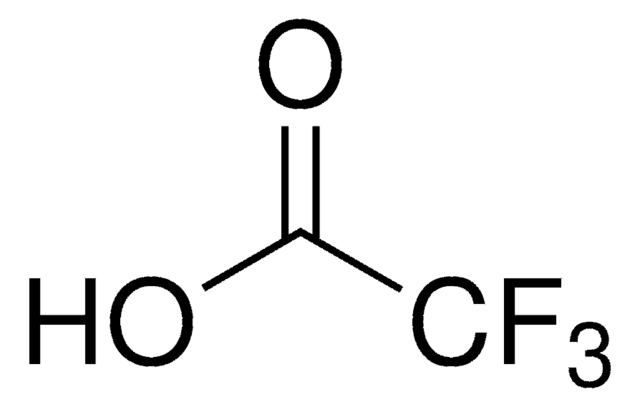1.08262
Acido trifluoroacetico
for spectroscopy Uvasol®
Sinonimo/i:
TFA
About This Item
Densità del vapore
3.9 (vs air)
Livello qualitativo
Tensione di vapore
97.5 mmHg ( 20 °C)
Saggio
≥99.8% (acidimetric)
Forma fisica
liquid
tecniche
UV/Vis spectroscopy: suitable
Impurezze
≤10% Water (Karl Fischer)
Residuo dopo evaporazione
≤0.005%
Colore
APHA: ≤10
Trasmittanza
265 nm, ≥10.0%
305 nm, ≥50.0%
320 nm, ≥80.0%
325 nm, ≥90.0%
Indice di rifrazione
n20/D 1.3 (lit.)
pH
1 (10 g/L in H2O)
P. eboll.
72.4 °C (lit.)
Punto di fusione
−15.4 °C (lit.)
Solubilità
soluble 10 g/mL
Densità
1.489 g/mL at 20 °C (lit.)
Temperatura di conservazione
2-30°C
Stringa SMILE
OC(C(F)(F)F)=O
InChI
1S/C2HF3O2/c3-2(4,5)1(6)7/h(H,6,7)
DTQVDTLACAAQTR-UHFFFAOYSA-N
Cerchi prodotti simili? Visita Guida al confronto tra prodotti
Categorie correlate
Descrizione generale
Applicazioni
- Characterization of ribostamycin and its impurities using a nano-quantity analyte detector: This study examines ribostamycin and its impurities using a nano-quantity analyte detector and details a systematic comparison of three different aerosol detectors. The role of trifluoroacetic acid as a mobile phase additive enhances detection sensitivity and analytical precision, making it crucial for accurate impurity profiling and pharmaceutical quality control (Meng et al., 2024).
- Paradigm Shift: Major Role of Ion-Pairing-Dependent Size Exclusion Effects in Bottom-Up Proteomics Reversed-Phase Peptide Separations: This research highlights the critical role of trifluoroacetic acid in modifying the ion-pairing and size exclusion properties of peptides during reversed-phase separations in proteomics. The study provides a deeper understanding of the mechanisms influencing peptide behavior, which is essential for developing more effective analytical techniques (Yeung et al., 2024).
- New fabric phase sorptive extraction for nondestructive analysis of heritage textile samples: This paper introduces a novel fabric phase sorptive extraction method using trifluoroacetic acid among other solvents to analyze heritage textile samples nondestructively. This method demonstrates significant potential in cultural heritage preservation and forensic science by allowing detailed analysis without damaging the original artifacts (Tanasescu et al., 2024).
- Preparation and characterization of stationary phase gradients on C8 liquid chromatography columns: The study discusses the preparation and characterization of stationary phase gradients for chromatography columns, with trifluoroacetic acid used to adjust the pH and ionic strength of the mobile phase. This modification is shown to enhance the chromatographic separation of complex mixtures, proving vital for analytical and preparative scale separations (Cecil et al., 2024).
- Optimization of Cyanocobalamin (Vitamin B(12)) Sorption onto Mesoporous Superparamagnetic Iron Oxide Nanoparticles: This investigation utilizes trifluoroacetic acid in the synthesis and functionalization of nanoparticles for efficient vitamin B(12) sorption. The study explores the implications for targeted drug delivery systems and bioseparation, demonstrating the adaptability and effectiveness of these engineered nanoparticles (Flieger et al., 2024).
Risultati analitici
Acqua K.F.): ≤ 0,10%
Numero colore (alfa): ≤ 10
Residuo all′evaporazione: ≤ 0,005%
Trasmissione UV (a 265 nm): ≥ 10,0%
Trasmissione UV (a 305 nm): ≥ 50,0%
Trasmissione UV (a 320 nm): ≥ 80,0%
Trasmissione UV (da 325 nm): ≥ 90,0%
Altre note
Note legali
Avvertenze
Danger
Indicazioni di pericolo
Classi di pericolo
Acute Tox. 4 Inhalation - Aquatic Chronic 3 - Eye Dam. 1 - Skin Corr. 1A
Codice della classe di stoccaggio
8A - Combustible, corrosive hazardous materials
Classe di pericolosità dell'acqua (WGK)
WGK 2
Punto d’infiammabilità (°F)
212.0 °F - Pensky-Martens closed cup
Punto d’infiammabilità (°C)
> 100 °C - Pensky-Martens closed cup
Certificati d'analisi (COA)
Cerca il Certificati d'analisi (COA) digitando il numero di lotto/batch corrispondente. I numeri di lotto o di batch sono stampati sull'etichetta dei prodotti dopo la parola ‘Lotto’ o ‘Batch’.
Possiedi già questo prodotto?
I documenti relativi ai prodotti acquistati recentemente sono disponibili nell’Archivio dei documenti.
I clienti hanno visto anche
Articoli
Being one of the most popular flavors, we present a HPLC fingerprint method and vanilla extract reference materials to help distinguish natural from synthetic or adulterated vanilla.
Protocolli
Straightforward HPTLC-MS analysis of lactose in dairy products (milk or yoghurt) using only protein crash, centrifugation and dilution as sample preparation.
Aripiprazole is an atypical antipsychotic and a partial dopamine agonist. It is primarily used in the treatment of schizophrenia, bipolar disorder, major depressive disorder, tic disorders, and irritability associated with autism. Aripiprazole was first approved by the U.S. Food and DrugAdministration in November 2002 for schizophrenia and by the European Medicines Agency in June 2004 for acute manic and mixed episodes associated with bipolar disorder.
Catalyst screening, KitAlysis™ High-Throughput Screening Kits, Thin layer chromatography (TLC), parallel analysis, parallel synthesisigh-Throughput Buchwald-Hartwig Amination Reaction Screening Kit, TLC-MS analysis
Il team dei nostri ricercatori vanta grande esperienza in tutte le aree della ricerca quali Life Science, scienza dei materiali, sintesi chimica, cromatografia, discipline analitiche, ecc..
Contatta l'Assistenza Tecnica.

